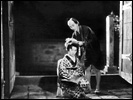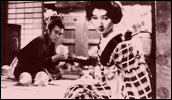Humanity and Paper Balloons
- Year
- 1937
- Original title
- Ninjo Kami-fusen
- Japanese title
- 人情紙風船
- Director
- Cast
- Running time
- 82 minutes
- Published
- 21 September 2005



by Jasper Sharp
For me at least, Eureka's DVD release of Sadao Yamanaka's Humanity and Paper Balloons under their Masters of Cinema banner - a collection that so far counts a healthy number of Japanese directors among the Langs, the Keatons, the Renoirs, and the Murnaus of film history - must be one of the most important of the year.
For starters, it is one of the few titles I can think of released outside of Japan in recent years from the country's pre-War period, its first Golden Age, long before Kurosawa's Rashomon prompted the international "discovery" of Japanese cinema in the 1950s. It is a bold move for any company to be thinking of a Western premiere for a film of this age, but a welcome one in that it provides a much-needed and long overdue snapshot of a particular cinematic era and culture virtually unrepresented overseas.
It has always been easy enough to read about these films, especially in the books of Donald Richie, a long-term champion of the older works. But outside of retrospectives such as the one devoted to Hiroshi Shimizu at Tokyo Filmex or the showcases that have graced the Pordenone Silent Film Festival in recent years, for non-Japanese speakers there has been little opportunity to see the films of some of the nation's most celebrated directors from its early days, including names like Mikio Naruse, Minoru Murata, Teinosuke Kinogasa, and Heinosuke Gosho.
Though it might seem a little late in the day to attempt to restore forgotten names from the 1920s and 30s to their rightful place in the firmly-established pantheon of international moviemaking greats, releases such as this do more than merely add the missing pieces to the jigsaw. The First Golden Age of Japanese Cinema wasn't so named for nothing. During the 30s, a lot of great Japanese filmmakers were making great films with great stories whose quality could match anything made in the West, and yet, aimed at local audiences, their flavour was 100% Japanese. Even if some of the physical prints have not made it from one side of the War to the other in anything approaching pristine condition (though I should mention here that the clear and blemish-free images on the Humanity and Paper Balloons DVD surpass all expectations in bringing the past back to life), many of the films themselves have stood the test of time admirably. And this is certainly one of them.
Make no mistake, Eureka certainly know what they are doing in introducing such a barely known name as Sadao Yamanaka through their collection. One of the reasons I am so happy to see this film out on subtitled DVD is that over the years, during numerous conversations with Japanese critics, curators, directors, and general cinephiles, this particular director's name has cropped up time and time again. His lofty status within Japanese film discourse can be easily gauged from the laudatory essays by director Shinji Aoyama and critic Kimitoshi Sato in the informative 22-page booklet that comes providing a swathe of essential contextual information with the package.
Born in 1909, Sadao Yamanaka made 22 films in all (or 26, if you count that the 1933 movie Nezumi-kozo Jirokichi was comprised of three feature-length instalments, and that the 1935 Kaido Shirozukin [trans: Phantom Thief White Hood] was released in two). Over half of these were silent, in an all-too-brief directing career that ran from his debut in 1932 with Iro no Genta: Dakinu no Nagadosu to this, the then 28-year-old director's final work before being drafted to serve in Manchuria where he died on the battlefield on April 17th 1938. Only three of his films survive, the other two being The Million Ryo Pot (Tange Sazen Yowa: Hyakuman Ryo no Tsubo, 1935), and Kouchiyama Soshun (1936).
Yamanaka made most of his films at Nikkatsu's Kyoto studios, but this final film was produced by P.C.L. (Photo Chemical Laboratories) shortly before the company was bought up by Ichizo Kobayashi and merged to form Toho in 1936 (initially acting in a distribution capacity only). Like all Yamanaka's films, Humanity and Paper Balloons is a jidai geki, but one poles apart from the majestic spectacle of, say, Akira Kurosawa's later works for this very same studio that were made after the war.
Here the story is driven by character rather than action, and set in a cramped Edo-period city slum. The overall tone is cynical and downbeat. Indeed, released after the bloody 'ni ni roku' incident of February 26th 1936, in which a group of military officers launched an ill-fated military coup to return power to the hands of the Showa Emperor and away from corrupt industrialists and politicians, and in the same year that the Marco Polo Bridge incident brought Japan into direct conflict with China and the rest of the world, what is most interesting is the extent to which it goes against the grain of this increasingly nationalistic time. The vision presented here is a far cry from "the good old days" of the samurai bushido code evoked in other period dramas of its day, movies portraying a mythic past untainted by foreign influence.
Historical dramas often present a safe way of renegotiating history to confront present predicaments. Rather than a highly-structured, well-ordered, and smooth-running society in which everyone knows their place in the hierarchy, Humanity and Paper Balloons portrays a world in which members of the debilitated samurai classes now rub shoulders with peasants and petty merchants, lorded over by puffed-up officials who have forgotten their roots, and policed by thugs recruited from the ranks of the yakuza. It could easily be read as a critique of society under the militaristic pre-war Showa government. Yamanaka's casting of members of the left-wing theatre troupe Zenshin-za further serves to underscore where he was coming from politically, a rather bold move considering the tyranny anyone with affiliations with the Communist Party was subjected to by the military police.
Visually the film also eschews the highly austere and ceremonial "monumental style" isolated by Darrell William Davis in his book Picturing Japaneseness, which during the war years set out to "transform Japanese tradition from a cultural legacy into a sacrament". Yamanaka portrays his cluttered rundown milieu teeming with human activity and an irrepressible energy that often threatens to burst forth from the screen.
The entire community of characters are introduced in the early scenes with the announcement of the suicide of an aging samurai neighbour, ignominiously enough by hanging himself, having been forced by poverty to trade in his sword for a bamboo one. Straight away the shanty denizens persuade the local innkeeper to provide 5 bottles of sake for the wake, to send off the deceased samurai's departing spirit and to keep morale up among the community after the third such death in recent weeks. The resulting formalities soon degenerate into a riotous bacchanal.
These early scenes present a snowballing accumulation of details, as the viewer is introduced to a whole host of figures who will all feature to a greater or lesser extent in the subsequent drama; the wily blind man Yabuichi who, despite his disability, always manages to get the edge over his competitors, the happy-go-lucky goldfish seller Genko, and the tragicomic figure of Shinya the barber, an inveterate gambler whose surreptitious gaming evenings organised under his own roof soon spell out his downfall. Though this wealth of information is initially confusing, it is not long before a pattern emerges in the chaos, with the film eventually ending after bringing events full circle through another drunken revel and a further tragedy.
In the meantime, in another world but a few meters away, the haughty official Mori runs his affairs from the Shirakoya Pawnbroker shop. Here he looks after the shopkeeper's daughter Okoma, who is being groomed up from her merchant roots to marry into the noble samurai class. Okoma is attended to by Chushichi, one of the pawn shop workers, who harbours his own secret love for her. Bridging the two poles of the local drinking hole and the pawnbrokers is Matajuro Unno, another samurai who has fallen on hard times. After the death of his father, he is forced to rely on the sales of the paper balloons made by his wife Otaki to survive, until such time as he can pass his father's letter of recommendation on to this political climber. But Mori doesn't want to know about his responsibilities to this son of a former associate. Using the tattooed yakuza heavies he holds in his pocket both to keep Unno from his doorstep and to clamp down on Shinya's illicit gambling activities, his unwavering authority soon prompts desperate survival measures from those in his ward.
Humanity and Paper Balloons is a fascinating time capsule of a movie that not only reframes the feudal period in which it is set to present a harsh critique of the social and political conditions of the time it was made, but also demonstrates just how tight, coherent, and entertaining films from this period actually were. One can only hope that Eureka's release will pave the way for further forgotten treasures from this overlooked trove of film history. In the meantime, this can only be described as an essential purchase.